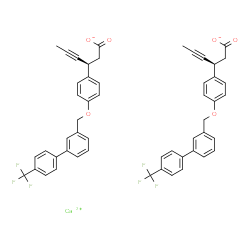1291087-14-3
| Name | AMG 837 |
|---|---|
| Synonyms |
Calcium bis[(3S)-3-(4-{[4'-(trifluoromethyl)-3-biphenylyl]methoxy}phenyl)-4-hexynoate]
Benzenepropanoic acid, β-1-propyn-1-yl-4-[[4'-(trifluoromethyl)[1,1'-biphenyl]-3-yl]methoxy]-, calcium salt, (βS)- (2:1) |
| Description | AMG 837 hemicalcium is a potent, orally bioavailable and partial agonist of GPR40/FFA1, inhibits specific [3H]AMG 837 binding at the human FFA1 receptor with a pIC50 of 8.13. AMG 837 hemicalcium could enhance insulin secretion and lower glucose levels in rodents[1][2][3]. |
|---|---|
| Related Catalog | |
| Target |
pIC50: 8.13 (FFA1)[3] |
| In Vitro | AMG 837 (1 nM-10 μM) stimulates insulin secretion in a glucose-dependent manner with an EC50 of 142±20 nM on islets isolated from mice[1]. AMG 837 stimulates Ca2+ flux with the EC50s of 13.5, 22.6 and 31.7 nM for human, mouse and rat receptors in CHO cells, respectively[1]. |
| In Vivo | AMG 837 (0.03-0.3 mg/kg; a single p.o.) improves glucose tolerance and enhances insulin secretion in Sprague-Dawley rats[1]. AMG 837 (0.5 mg/kg; p.o.) displays excellent oral bioavailability (%F = 84) and a total plasma Cmax of 1.4 µM[1]. AMG 837 (0.03-0.3 mg/kg; p.o. once daily for 21 days) reduces glucose levels and increases insulin levels following glucose challenge in vivo[1]. Animal Model: 8-week old Sprague-Dawley rats[1] Dosage: 0.03, 0.1, 0.3 mg/kg Administration: A single p.o. administration Result: Reduced the post-prandial glucose with the half-maximal dose of 0.05 mg/kg. Animal Model: 8-week old Zucker Fatty Rats[1] Dosage: 0.03, 0.1, 0.3 mg/kg Administration: Oral gavage once daily for 21 days Result: Decreased glucose AUC values during the glucose tolerance test (GTT) to 7%, 15%, and 25% at 0.03, 0.1 and 0.3 mg/kg, respectively. Increased insulin levels in the mid- and high-dose groups. Not affected body weights during the 21-day treatment. |
| References |
| Molecular Formula | C26H21F3O3.1/2Ca |
|---|---|
| Molecular Weight | 914.939 |
| Exact Mass | 914.235474 |
